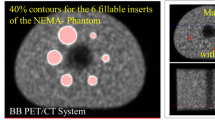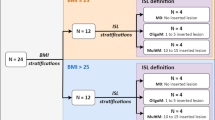Abstract
Objectives
Dedicated breast PET (dbPET) systems have improved the detection of small breast cancers but have increased false-positive diagnoses due to an increased chance of noise detection. This study examined whether reproducibility assessment using paired images helped to improve noise discrimination and diagnostic performance in dbPET.
Methods
This study included 21 patients with newly diagnosed breast cancer who underwent [18F]FDG-dbPET and contrast-enhanced breast MRI. A 10-min dbPET data scan was acquired per breast, and two sets of reconstructed images were generated (named dbPET-1 and dbPET-2, respectively), each of which consisted of randomly allocated 5-min data from the 10-min data. Uptake spots higher than the background were indexed for the study with visual assessment. All indexed uptakes on dbPET-1 were evaluated using dbPET-2 for reproducibility. MRI findings based on the Breast Imaging-Reporting and Data System (BI-RADS) 2013 were used as the gold standard. Uptake spots that corresponded to BI-RADS 1 on MRI were considered noise, while those with BI-RADS 4b–6 were considered malignancies. The diagnostic performance of dbPET for malignancy was evaluated using four different criteria: any uptake on dbPET-1 regarded as positive (criterion A), a subjective visual assessment of dbPET-1 (criterion B), reproducibility assessment between dbPET-1 and dbPET-2 (criterion C), and a combination of B and C (criterion D).
Results
A total of 213 indexed uptake spots were identified on dbPET-1, including 152, 15, 6, 6, and 34 lesions classified as BI-RADS MRI categories 1, 2, 4b, 4c, and 5, respectively. Overall, 31.9% of the index uptake values were reproducible. All malignant lesions were reproducible, whereas 93.4% of noise was not reproducible. The sensitivities for malignancy for criteria A, B, C, and D were 100%, 91.3%, 100%, and 91.3%, respectively, with positive predictive values (PPVs) of 21.4%, 68.9%, 67.6%, and 82.4%, respectively.
Conclusions
Our results demonstrated that reproducibility assessment helped reduce false-positive findings caused by noise on dbPET without lowering the sensitivity for malignancy. While subjective visual assessment was also efficient in increasing PPV, it occasionally missed malignant uptake.





Similar content being viewed by others
Data availability
The datasets analyzed during the current study are available from the corresponding author on reasonable request.
References
Azamjah N, Soltan-Zadeh Y, Zayeri F. Global trend of breast cancer mortality rate: a 25-year study. Asian Pac J Cancer Prev. 2019;20:2015–20.
Lima SM, Kehm RD, Terry MB. Global breast cancer incidence and mortality trends by region, age-groups, and fertility patterns. EClinicalMedicine. 2021;38: 100985.
Lebron-Zapata L, Jochelson MS. Overview of breast cancer screening and diagnosis. PET Clin. 2018;13:301–23.
Koolen BB, Vogel WV, VranckenPeeters MJ, Loo CE, Rutgers EJ, Valdés Olmos RA. Molecular imaging in breast cancer: from whole-body PET/CT to dedicated breast PET. J Oncol. 2012;2012: 438647.
Avril N, Rosé CA, Schelling M, Dose J, Kuhn W, Bense S, et al. Breast imaging with positron emission tomography and fluorine-18 fluorodeoxyglucose: use and limitations. J Clin Oncol. 2000;18:3495–502.
Sueoka S, Sasada S, Masumoto N, Emi A, Kadoya T, Okada M. Performance of dedicated breast positron emission tomography in the detection of small and low-grade breast cancer. Breast Cancer Res Treat. 2021;187:125–33.
Trägårdh E, Minarik D, Almquist H, Bitzén U, Garpered S, Hvittfelt E, et al. Impact of acquisition time and penalizing factor in a block-sequential regularized expectation maximization reconstruction algorithm on a Si-photomultiplier-based PET-CT system for 18F-FDG. EJNMMI Res. 2019;9:64.
Boellaard R, Krak NC, Hoekstra OS, Lammertsma AA. Effects of noise, image resolution, and ROI definition on the accuracy of standard uptake values: a simulation study. J Nucl Med. 2004;45:1519–27.
Nishimatsu K, Nakamoto Y, Miyake KK, Ishimori T, Kanao S, Toi M, et al. Higher breast cancer conspicuity on dbPET compared to WB-PET/CT. Eur J Radiol. 2017;90:138–45.
Miyake KK, Matsumoto K, Inoue M, Nakamoto Y, Kanao S, Oishi T, et al. Performance evaluation of a new dedicated breast PET scanner using NEMA NU4-2008 standards. J Nucl Med. 2014;55:1198–203.
Cherry SR, Dahlbom M. PET: physics, instrumentation, and scanners. Cham: Springer; 2006.
Tanaka E, Kudo H. Subset-dependent relaxation in block-iterative algorithms for image reconstruction in emission tomography. Phys Med Biol. 2003;48:1405–22.
D’Orsi CJ, Sickles EA, Mendelson EB, Morris EA, editors. ACR BI-RADS atlas: breast imaging reporting and data system. Reston: American College of Radiology; 2013.
Satoh Y, Motosugi U, Imai M, Omiya Y, Onishi H. Evaluation of image quality at the detector’s edge of dedicated breast positron emission tomography. EJNMMI Phys. 2021;8:5.
Miyake KK, Kataoka M, Ishimori T, Matsumoto Y, Torii M, Takada M, et al. A proposed dedicated breast PET lexicon: standardization of description and reporting of radiotracer uptake in the breast. Diagnostics. 2021;11:1267.
Thompson CJ, Murthy K, Picard Y, Weinberg IN, Mako R. Positron emission mammography (PEM): a promising technique for detecting breast cancer. IEEE Trans Nucl Sci. 1995;42:1012–7.
Ulaner GA. PET/CT for patients with breast cancer: where is the clinical impact? AJR Am J Roentgenol. 2019;213:254–65.
Freifelder R, Karp JS. Dedicated PET scanners for breast imaging. Phys Med Biol. 1997;42:2463–80.
Satoh Y, Imai M, Ikegawa C, Onishi H. Image quality evaluation of real low-dose breast PET. Jpn J Radiol. 2022;40:1186–93.
Lodge MA, Chaudhry MA, Wahl RL. Noise considerations for PET quantification using maximum and peak standardized uptake value. J Nucl Med. 2012;53:1041–7.
Dong A, Wang Y, Lu J, Zuo C. Spectrum of the breast lesions with increased 18F-FDG uptake on PET/CT. Clin Nucl Med. 2016;41:543–57.
Berg WA, Madsen KS, Schilling K, Tartar M, Pisano ED, Larsen LH, et al. Breast cancer: comparative effectiveness of positron emission mammography and MR imaging in presurgical planning for the ipsilateral breast. Radiology. 2011;258:59–72.
Acknowledgements
We thank Tae Oishi, RT, for her contribution to dbPET image acquisition, and Yoshiyuki Yamakawa from Shimadzu Cooperation for his technical support in the dbPET image reconstruction. We also thank Editage for the English language editing.
Funding
This work was supported by a Grant-in-Aid for Scientific Research from the Ministry of Education, Culture, Sports, Science, and Technology of Japan (19K17196).
Author information
Authors and Affiliations
Corresponding author
Ethics declarations
Conflict of interest
Author Masakazu Toi has received research support from Shimadzu Corporation.
Ethical approval
This study was conducted in accordance with the principles of the Declaration of Helsinki. Approval was granted by the Ethics Committee of the Kyoto University Graduate School and Faculty of Medicine. (Approval number, R1213).
Consent to participate
The requirement for informed consent was waived by the Ethics Committee of Kyoto University Graduate School and Faculty of Medicine owing to the retrospective design.
Additional information
Publisher's Note
Springer Nature remains neutral with regard to jurisdictional claims in published maps and institutional affiliations.
Rights and permissions
Springer Nature or its licensor (e.g. a society or other partner) holds exclusive rights to this article under a publishing agreement with the author(s) or other rightsholder(s); author self-archiving of the accepted manuscript version of this article is solely governed by the terms of such publishing agreement and applicable law.
About this article
Cite this article
Yuge, S., Miyake, K.K., Ishimori, T. et al. Reproducibility assessment of uptake on dedicated breast PET for noise discrimination. Ann Nucl Med 37, 121–130 (2023). https://doi.org/10.1007/s12149-022-01809-6
Received:
Accepted:
Published:
Issue Date:
DOI: https://doi.org/10.1007/s12149-022-01809-6




